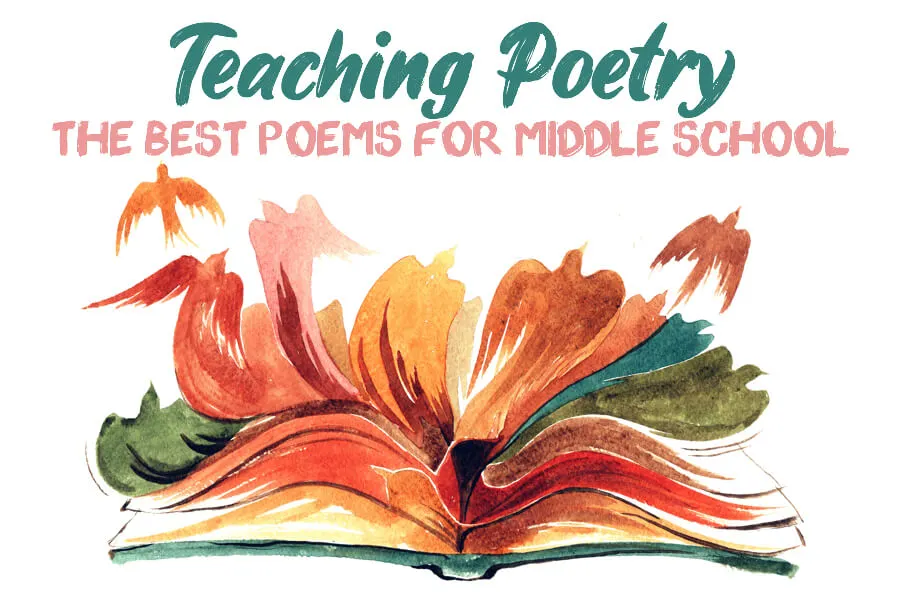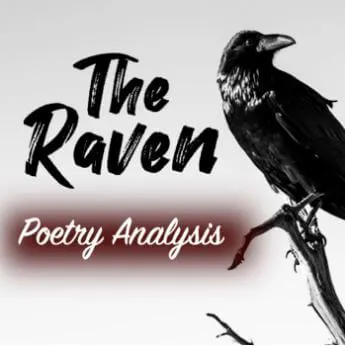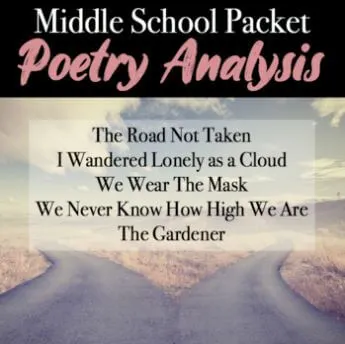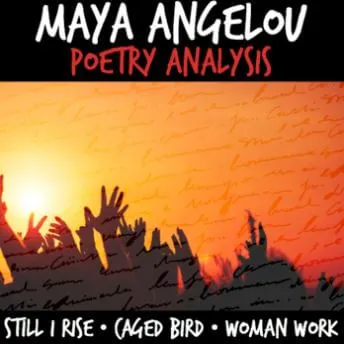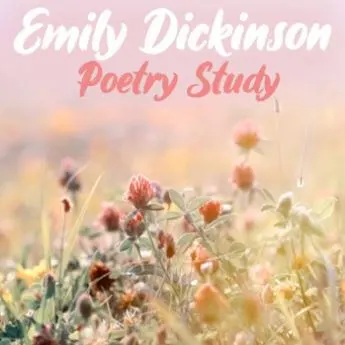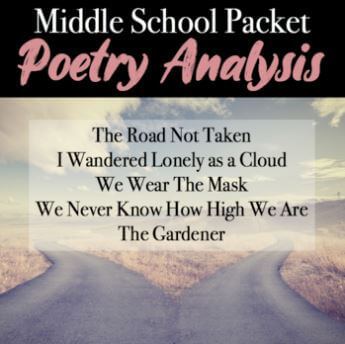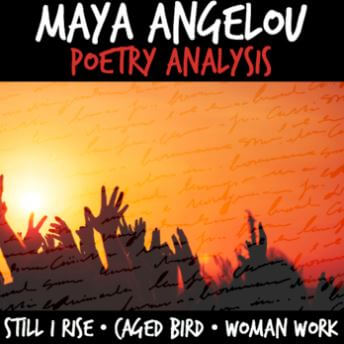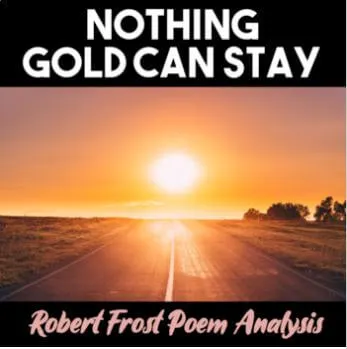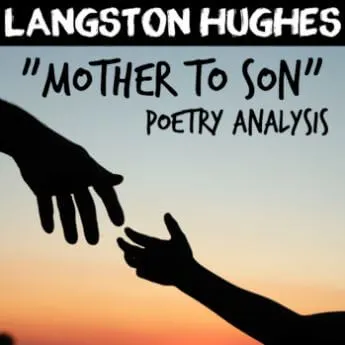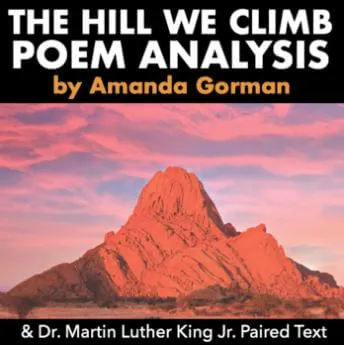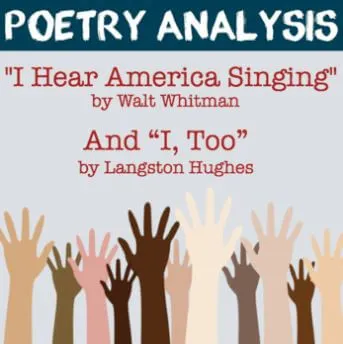It’s that time of year again! That’s right: poetry time. You are ready to teach your students all about rhyme scheme, alliteration, symbolism, and personification… However, you need some poems to do that, and so you will need to be equipped with a selection of poems that are both interesting and contain poetic and literary devices. Well, you have come to the right place because below is a list of poems for the most effective methods of teaching poetry to middle school students.
#1 Jabberwocky by Lewis Carroll
If you are wanting to teach onomatopoeia and need plenty of examples, then the poem “Jabberwocky” is the number one text you need. Lewis Carroll’s poem looks like a bunch of nonsense words at first, but as you dive deeper into the poem, you will see that these nonsense words come together with meaning. “Jabberwocky” contains numerous onomatopoeia words besides the boring “crash,” “bang,” and “boom” words that are commonly taught during an onomatopoeia lesson. Instead, the unusual onomatopoeia words in “Jabberwocky” require students to actually use the sound words to determine their meanings.
It might seem a little daunting to students at first sight who may perceive “Jabberwocky” as a poem that was written in a foreign language, but with a little push from you, they can focus on the onomatopoeia words to decipher the narrative poem’s meaning.
#2 The Pied Piper of Hamelin by Robert Browning
Besides having many examples of different sound devices and figurative language in this poem, it also is about a popular fairytale. Your students may remember hearing the story about the “Pied Piper of Hamelin” when their parents read them bedtime stories. Therefore, they can tie the events from the poem and the story together. (If your students can recall the story, this may be a perfect time to compare and contrast the poem with the fairytale.)
“The Pied Piper of Hamelin” contains examples of onomatopoeia, alliteration, and imagery amongst a few more advanced literary devices. If you (or your students) are up for a challenge, then you can introduce anaphora and caesura into your lesson with this poem.
#3 The Raven by Edgar Allan Poe
Expose your students to the literary work that made Poe a household name. In this poem, the speaker is mournfully grieving over his lost love while being taunted by a raven who can’t seem to take a hint. This poem provides more than just a dreadful and eerie tone, but it also includes alliteration, allusion, rhyme, and repetition. How can anyone forget about the “rapping” and “tapping at his chamber door,” and the poem’s repeated famous word “Nevermore”?
Don’t feel like you have to use “The Raven” at Halloween time because your students will love this legendary poem at any time of the year. They may even know some of those memorable repeated lines. Even the Simpsons once did a spoof on “The Raven.”
#4 The Rime of the Ancient Mariner by Samuel Taylor Coolidge
“Water, water, every where,
And all the boards did shrink;
Water, water, every where,
Nor any drop to drink.”
Many people can recite the famous lines above, or some variation of them, yet it is not well-known that the quote comes from the poem, “The Rime of the Ancient Mariner.” Even though it is a rather lengthy poem, it can be conveniently divided into sections while teaching.
This poem is an example of a lyrical ballad and has a distinct rhythm to it with ample amounts of repetition. Alliteration, consonance, assonance, and internal rhyme can all be taught while analyzing this poem with students as well.
#5 The Road Not Taken by Robert Frost
A true classic! “The Road Not Taken” is a poem included in almost every textbook, and that is for good reason. The whole poem follows a specific ABAAB rhyme scheme and is constructed with a beautiful, simplistic parallelism that allows students to analyze this poem with ease. This poem is extremely popular with young students because it dives into the commonly shared quandary and question: What should I do with my life? What path should I take? These tough life choices are perfectly yet ambiguously defined in this poem; it’s great for students to dissect the poem for its multiple themes, metaphors, and messages.
#6 Song of Myself by Walt Whitman
Many of the poems used in middle school classrooms contain a specific rhyme scheme—which is much appreciated as it makes it easy to read. Be that as it may, if you are looking for a free verse poem without any end rhyme, “Song of Myself” is a great choice. This poem is an ideal poem to teach free verse and imagery. It’s quite long but can be broken down or chunked easily for students. This poem is also great for teaching symbolism, personification, anaphora, alliteration, and the posing of a rhetorical question in literature. The repetition of words gives the poem a musical effect, plus the overall message will leave you feeling happy and wanting to make the world a better place!
#7 Still I Rise by Maya Angelou
This poem also poses rhetorical questions for the readers… plus you can’t have a list of the most influential poems without work by the famous Maya Angelou. In the poem “Still I Rise,” Angelou uses repetition to emphasize the inspirational theme and confident tone of the poem. The speaker keeps repeating the phrase “I’ll rise” to show that no struggles can hold her down (or no person can hold her back); she will always thrive on. The speaker is surviving any adversity thrown her way and it actually gives her motivation to keep going and rise again. This poem also includes similes, alliteration, and a tone that is motivational, aspiring, and resilient.
#8 The Eagle by Alfred Lord Tennyson
With precise language, this poem contains alliteration and imagery within a different type of structure known as a tercet. This would provide students with a poem that does not contain the standard four-lined stanzas. Instead, it is set up in three-lined rhyming stanzas.
Besides the literary devices, you could compare and contrast this poem with other 4-lined stanza poems to determine how effective (or not) Tennyson structured his poem as a tercet.
#9 The Base Stealer by Robert Francis
By now, your students have probably been identifying similes for years. As you help your students continually develop their reading comprehension skills, students should not only be able to identify similes but analyze the impact of figurative language on a text. “The Base Stealer” is a great option to help develop these skills. The poem includes a number of similes that paint the picture of an exciting baseball game. The speaker is watching a player make a tough decision to either steal a base or not. Students can really imagine themselves in the speaker’s shoes through the imagery and figurative language; the repetition of words creates a suspenseful atmosphere, making readers feel as if they were really at the game. As a bonus, the poem also contains onomatopoeia.
#10 Hope is the Thing with Feathers by Emily Dickinson
One of the more popular poems written is Emily Dickinson’s “Hope is the Thing with Feathers.” Starting with the title, it is apparent that this poem contains a metaphor. It actually contains an extended metaphor that is described throughout the poem. Dickinson portrays hope as a bird that lives within the human souI. The bird sings when times get tough, and cannot be defeated easily. This short, whimsical poem contains sensory details that students can analyze for deeper meaning and use the presence of metaphors to determine the theme.
#11 Oh Captain, My Captain by Walt Whitman
“O Captain! My Captain!” is an elegy written by Walt Whitman to commemorate the death of President Abraham Lincoln. The extended metaphor compares Captain to President and is also a great example of allusion because it is a subtle reference to Abraham Lincoln. Additionally, Whitman’s descriptive words represent a juxtaposition of both victory and loss—victory of the war, but loss of a leader. Through diction and syntax, this lyrical poem accomplishes a sorrowful and solemn mood. As an elegy to Abraham Lincoln, you can have your students compare and contrast odes with elegies using this poem.
#12 I Wandered Lonely as a Cloud by William Wordsworth
Another poem that includes multiple different types of sound devices and figurative language is Wordsworth’s “I Wandered Lonely as a Cloud.” This poem is popular with middle school students due to its imagery and use of similes, alliteration, assonance, consonance, metaphors, and personification. The speaker is feeling lonely until he/she notices the beauty around them. The description of golden daffodils and sparkling waves dancing leaves the speaker feeling in awe of nature. This poem has a blissful and joyous tone; the speaker’s heart is filled with pleasure reminiscing on the beauty of nature.
#13 Sarah Cynthia Sylvia Stout Would Not Take the Garbage Out by Shel Silverstein
No poem list would be complete without a poem by Shel Silverstein. Even though this poem may seem a little elementary for middle school students, it is rich in hyperboles. The concept is that the garbage pile has grown so large, it has reached the sky and has even crossed state lines! This poem is excellent to use as an introduction to hyperboles, alliteration, and/or rhyming. Silverstein’s poem would provide a good foundation for these literary devices as you move on to more challenging poems.
#14 Red, Red Rose by Robert Burns
For a more difficult poem showcasing hyperboles, “Red, Red Rose” may be your best bet. That’s if your middle schoolers can handle a love poem. In addition to the hyperboles, it also contains similes and metaphors. Its distinct ABBA rhyme scheme used throughout the poem allows you to focus on a simple rhyme scheme that doesn’t change throughout the poems unlike other poems in which can have varied rhyme schemes.
#15 The Cremation of Sam McGhee by Robert Service
The poet may not be as recognized as his infamous poem, “The Cremation of Sam McGhee,” but Robert Service’s poem is included in many middle school Language Arts classrooms today. With irony, similes, metaphors, personification, and hyperboles surrounding a theme about death, both students and teachers favor this poem but for different reasons. Students appreciate a different theme and setting as it strays from the typical poems about nature, love, and friendship. Teachers, on the other hand, incorporate this poem into their study since it provides so many different examples of figurative language.
#16 The Highwayman by Alfred Noyes
Symbolism definitely needs to be taught in order for your students to understand any abstract poem. In this case, “The Highwayman” includes a variety of symbols for your students to decipher. This narrative poem is a dark story, so you may want to be aware of that before including this one in your collection (two forbidden lovers end up dead as a result of their affair). This nail-biting poem is jam-packed with other literary devices like alliteration, metaphors, and enjambment.
#17 Caged Bird by Maya Angelou
This poem in particular is excellent for teaching figurative language because the entire poem is a metaphor. The way a caged bird is unable to enjoy freedom like other birds due to its cage, clipped wings, and tied feet is comparable to how African Americans felt regarding basic civil rights during Angelou’s time. The bird sings for hope and freedom which gives this historically significant poem a glimmer of positivity in a time of oppression and adversity. The juxtaposition illustrates how the lives of the privileged are unaffected by those who are being caged and mistreated in society.
#18 Nothing Gold Can Stay by Robert Frost
A poem that lends itself to symbolism is Robert Frost’s “Nothing Gold Can Stay.” As recited in the popular movie and novel, The Outsiders, the “gold” in a sunset symbolizes how nothing beautiful or precious stays that way. This Frost poem also contains metaphors, rhythm, and natural imagery. If you are up to merging an awesome novel with your poetry unit, this just might be the best marriage. Since the novel, The Outsiders, is often found on many middle school reading lists, this would be a great way to include a novel study with a small poetry unit. Of course, your students would also probably appreciate spending a few days watching the movie afterwards too.
#19 Mother to Son by Langston Hughes
As a lyrical poem written during the Harlem Renaissance, Langston Hughes brings a rich culture of his poetry into the common classroom. This poem illustrates the hardships of life during his era as well as strong metaphors and examples of alliteration. Another element found in Hughes’ poem is allusion. By comparing life’s hardships to a staircase, Hughes alludes to Jacob’s Ladder, a biblical reference of a ladder which connects heaven to earth. This poem is also structured as conversation between mother and son which lends a great lesson to students on dialect and tone.
#20 We Real Cool by Gwendolyn Brooks
“We Real Cool” differs from other poems because it doesn’t contain the needed figurative language or sound devices as other poems do. Still, it offers something better which is its message. Students like this poem because it’s short, and they can relate to the theme from this poem, which is if you live rebelliously and in a self-destructive manner, you will die young; however, the poem isn’t necessarily a warning against bad behavior as much as it is a celebration of living life to the fullest. A great classroom activity for students is to rewrite the poem using the same style and structure but with a different topic.
#21 The Charge of the Light Brigade by Alfred Lord Tennyson
It is difficult to interest boys in sweet love poems or poems expressing the beauty of nature, but this poem is your best bet because it is a historical narrative poem about the harshness of war. Taking a different turn in your poetry unit may wake up your male students to a curiosity of poems. Besides this, Tennyson’s poem contains repetition, allusion, tone, imagery, and metaphors.
#22 The Red Wheelbarrow by William Carlos Williams
Countless poems contain imagery that make it easy for students to identify the scene described before them. While this is true, a shorter poem can be just as useful, since it makes a more rigid approach for students to explain the imagery. With this brief poem (only 16 words!), your students must use their prior knowledge in order to draw conclusions about the imagery in this poem. If you have an advanced group of students, this poem would be effective for discussions about its unique structure.
#23 The Hill We Climb by Amanda Gorman
Amanda Gorman is known for her tearjerking poem presented at President Joe Biden’s 2021 inauguration. Amanda Gorman is the youngest inaugural poet in U.S. history and her presence had the nation talking about her poem “The Hill We Climb” for days on end. It is about patience and humility in today’s problematic society. If America can unite and come together as one, we can create a better future. This poem is perfect for a real-life conversation with students about the injustice and current events happening in the country today. Gorman uses anaphora, enjambment, metaphors, alliteration, and allusion in this poem.
#24 and #25 I, Too by Langston Hughes and I Hear America Singing by Walt Whitman
What’s a poetry unit without using some paired texts?Hughes’ poem is written with Whitman’s poem in mind, making these two texts the perfect match. Whitman’s poem portrays America as a nation of hard workers who enjoy making a living while Hughes’ poem portrays an America that is unfair, unjust, and does not allow him the same freedoms, as an African American man. Hughes is quite literally saying, that he too is American—just as all the workers mentioned in Whitman’s poem. The irony is that Whitman states each person sings what “belongs” to him or her but during the time it was written, America still had slaves. Slaves were not allowed to own anything and had no such freedoms. The poems are both rich with literary devices and would make for a great essay assignment for students posing questions such as: What does America look like to you? How does it compare to Whitman’s and Hughes’ experience?
Good luck with your poetry unit as any of these poems will surely make it a success! Happy poetry-teaching!
